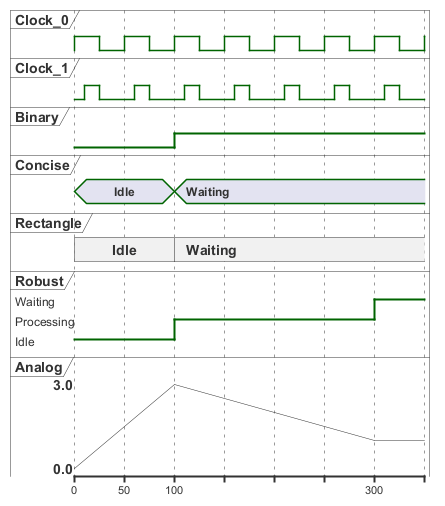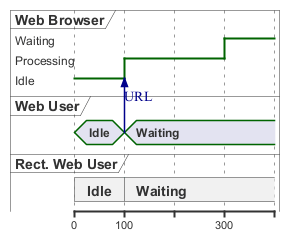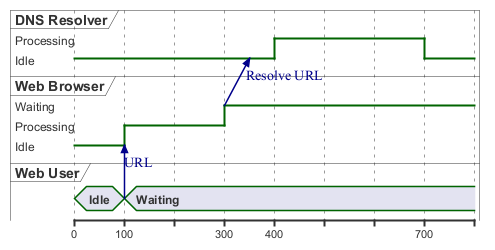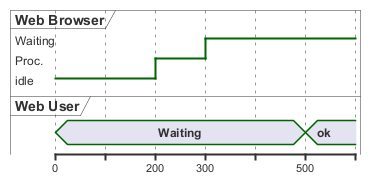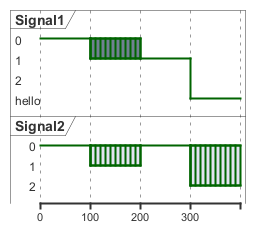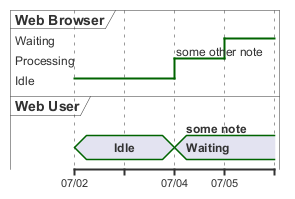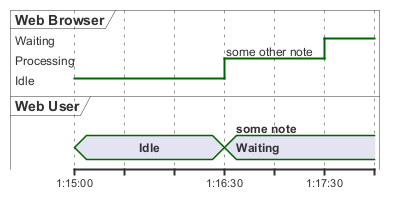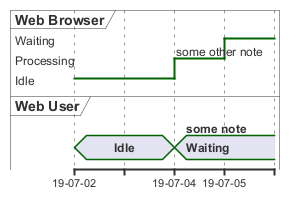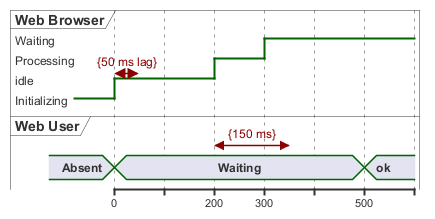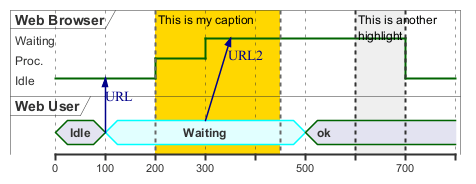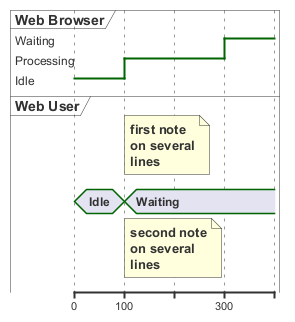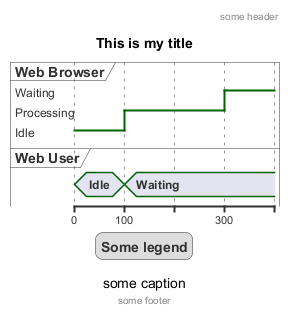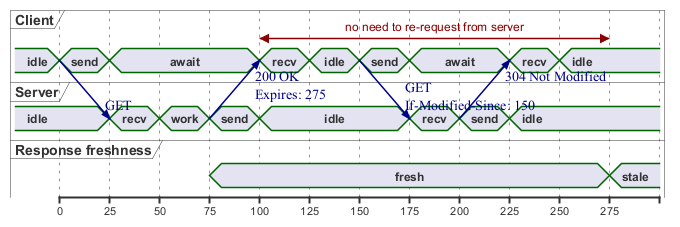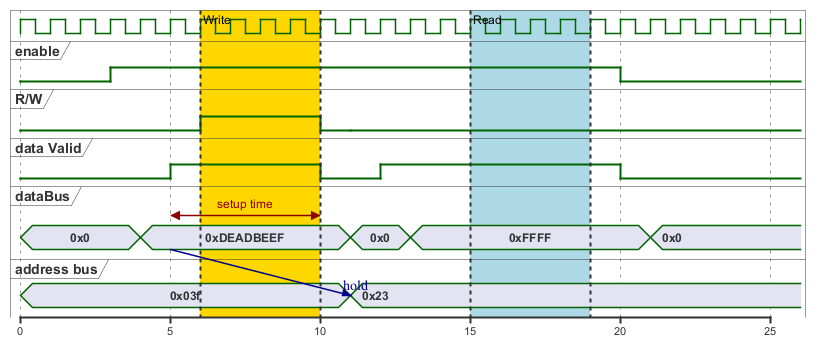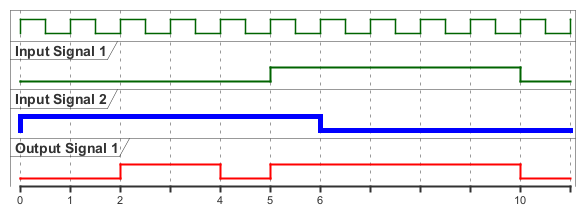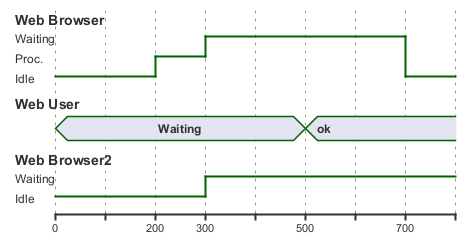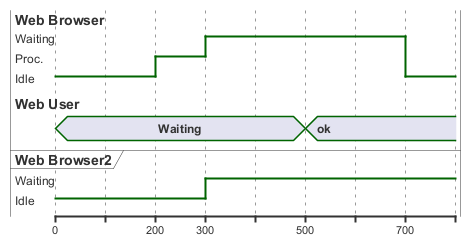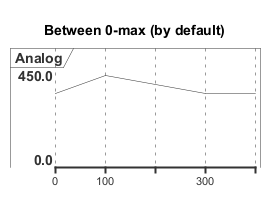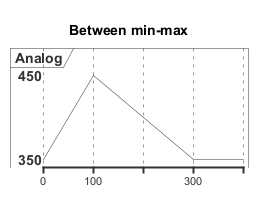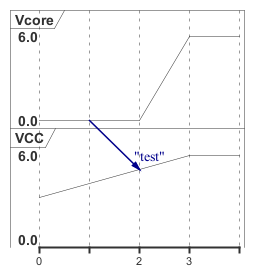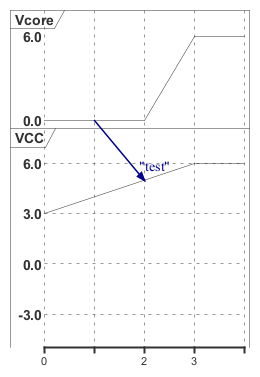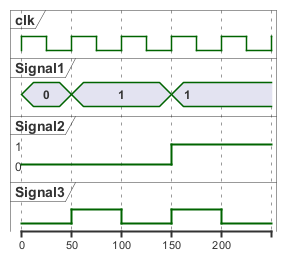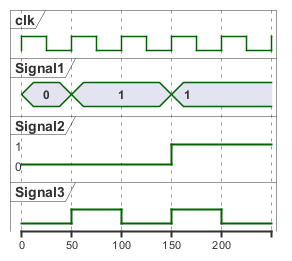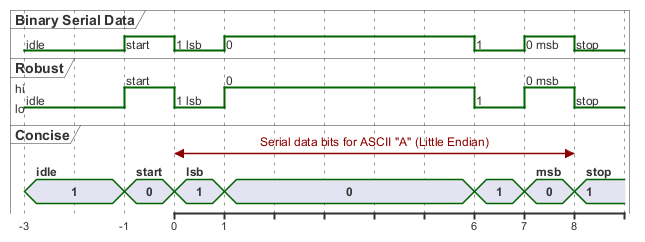A
Timing Diagram in UML is a specific type of
interaction diagram that visualizes the
timing constraints of a system. It focuses on the
chronological order of events, showcasing how different objects interact with each other over time.
Timing diagrams are especially useful in
real-time systems and
embedded systems to understand the behavior of objects throughout a given period.
You declare participant using the following keywords, depending on how you want them to be drawn.
|
Keyword
|
Description
|
analog
|
An analog signal is continuous, and the values are linearly interpolated between the given setpoints
|
binary
|
A binary signal restricted to only 2 states
|
clock
|
A clocked signal that repeatedly transitions from high to low, with a period, and an optional pulse and offset
|
concise
|
A simplified concise signal designed to show the movement of data (great for messages)
|
rectangle
|
A rectangle signal similar to concise but within a rectangle shape
|
robust
|
A robust complex line signal designed to show the transition from one state to another (can have many states)
|
You define state change using the
@ notation, and the
is verb.
|
🎉 Copied!


|
@startuml
robust "Web Browser" as WB
concise "Web User" as WU
rectangle "Rect. Web User" as RWU
@0
WU is Idle
RWU is Idle
WB is Idle
@100
WU is Waiting
RWU is Waiting
WB is Processing
@300
WB is Waiting
@enduml
|
|
🎉 Copied!


|
@startuml
clock "Clock_0" as C0 with period 50
clock "Clock_1" as C1 with period 50 pulse 15 offset 10
binary "Binary" as B
concise "Concise" as C
rectangle "Rectangle" as Re
robust "Robust" as R
analog "Analog" as A
@0
C is Idle
R is Idle
Re is Idle
A is 0
@100
B is high
C is Waiting
Re is Waiting
R is Processing
A is 3
@300
R is Waiting
A is 1
@enduml
|
[Ref. QA-14631, QA-14647, QA-11288 and GH-2409]
It's also possible to have binary and clock signal, using the following keywords:
|
🎉 Copied!


|
@startuml
clock clk with period 1
binary "Enable" as EN
@0
EN is low
@5
EN is high
@10
EN is low
@enduml
|
You can add message using the following syntax.
|
🎉 Copied!


|
@startuml
robust "Web Browser" as WB
concise "Web User" as WU
rectangle "Rect. Web User" as RWU
@0
WU is Idle
RWU is Idle
WB is Idle
@100
WU -> WB : URL
WU is Waiting
RWU is Waiting
WB is Processing
@300
WB is Waiting
@enduml
|
It is possible to use relative time with
@.
|
🎉 Copied!


|
@startuml
robust "DNS Resolver" as DNS
robust "Web Browser" as WB
concise "Web User" as WU
@0
WU is Idle
WB is Idle
DNS is Idle
@+100
WU -> WB : URL
WU is Waiting
WB is Processing
@+200
WB is Waiting
WB -> DNS@+50 : Resolve URL
@+100
DNS is Processing
@+300
DNS is Idle
@enduml
|
Instead of using absolute or relative time on an absolute time you can define a time as an anchor point by using the
as keyword and starting the name with a
:.
@XX as :<anchor point name>
|
🎉 Copied!


|
@startuml
clock clk with period 1
binary "enable" as EN
concise "dataBus" as db
@0 as :start
@5 as :en_high
@10 as :en_low
@:en_high-2 as :en_highMinus2
@:start
EN is low
db is "0x0000"
@:en_high
EN is high
@:en_low
EN is low
@:en_highMinus2
db is "0xf23a"
@:en_high+6
db is "0x0000"
@enduml
|
Rather than declare the diagram in chronological order, you can define it by participant.
|
🎉 Copied!


|
@startuml
robust "Web Browser" as WB
concise "Web User" as WU
@WB
0 is idle
+200 is Proc.
+100 is Waiting
@WU
0 is Waiting
+500 is ok
@enduml
|
You can also set a specific scale.
|
🎉 Copied!


|
@startuml
concise "Web User" as WU
scale 100 as 50 pixels
@WU
0 is Waiting
+500 is ok
@enduml
|
When using absolute Times/Dates, 1 "tick" is equivalent to 1 second.
|
🎉 Copied!


|
@startuml
concise "Season" as S
'30 days is scaled to 50 pixels
scale 2592000 as 50 pixels
@2000/11/01
S is "Winter"
@2001/02/01
S is "Spring"
@2001/05/01
S is "Summer"
@2001/08/01
S is "Fall"
@enduml
|
You can also define an inital state.
|
🎉 Copied!


|
@startuml
robust "Web Browser" as WB
concise "Web User" as WU
WB is Initializing
WU is Absent
@WB
0 is idle
+200 is Processing
+100 is Waiting
@WU
0 is Waiting
+500 is ok
@enduml
|
A signal could be in some undefined state.
Intricated or undefined robust state
|
🎉 Copied!


|
@startuml
robust "Signal1" as S1
robust "Signal2" as S2
S1 has 0,1,2,hello
S2 has 0,1,2
@0
S1 is 0
S2 is 0
@100
S1 is {0,1} #SlateGrey
S2 is {0,1}
@200
S1 is 1
S2 is 0
@300
S1 is hello
S2 is {0,2}
@enduml
|
Intricated or undefined binary state
|
🎉 Copied!


|
@startuml
clock "Clock" as C with period 2
binary "Enable" as EN
@0
EN is low
@1
EN is high
@3
EN is low
@5
EN is {low,high}
@10
EN is low
@enduml
|
[Ref. QA-11936 and QA-15933]
It is also possible to hide some state.
|
🎉 Copied!


|
@startuml
concise "Web User" as WU
@0
WU is {-}
@100
WU is A1
@200
WU is {-}
@300
WU is {hidden}
@400
WU is A3
@500
WU is {-}
@enduml
|
|
🎉 Copied!


|
@startuml
scale 1 as 50 pixels
concise state0
concise substate1
robust bit2
bit2 has HIGH,LOW
@state0
0 is 18_start
6 is s_dPause
8 is 10_data
14 is {hidden}
@substate1
0 is sSeq
4 is sPause
6 is {hidden}
8 is dSeq
12 is dPause
14 is {hidden}
@bit2
0 is HIGH
2 is LOW
4 is {hidden}
8 is HIGH
10 is LOW
12 is {hidden}
@enduml
|
[Ref. QA-12222]
It is possible to hide time axis.
|
🎉 Copied!


|
@startuml
hide time-axis
concise "Web User" as WU
WU is Absent
@WU
0 is Waiting
+500 is ok
@enduml
|
It is possible to use time or date.
|
🎉 Copied!


|
@startuml
robust "Web Browser" as WB
concise "Web User" as WU
@2019/07/02
WU is Idle
WB is Idle
@2019/07/04
WU is Waiting : some note
WB is Processing : some other note
@2019/07/05
WB is Waiting
@enduml
|
|
🎉 Copied!


|
@startuml
robust "Web Browser" as WB
concise "Web User" as WU
@1:15:00
WU is Idle
WB is Idle
@1:16:30
WU is Waiting : some note
WB is Processing : some other note
@1:17:30
WB is Waiting
@enduml
|
[Ref. QA-7019]
It is also possible to change date format.
|
🎉 Copied!


|
@startuml
robust "Web Browser" as WB
concise "Web User" as WU
use date format "YY-MM-dd"
@2019/07/02
WU is Idle
WB is Idle
@2019/07/04
WU is Waiting : some note
WB is Processing : some other note
@2019/07/05
WB is Waiting
@enduml
|
You can manage the time-axis labels.
Label on each tick (by default)
|
🎉 Copied!


|
@startuml
scale 31536000 as 40 pixels
use date format "yy-MM"
concise "OpenGL Desktop" as OD
@1992/01/01
OD is {hidden}
@1992/06/30
OD is 1.0
@1997/03/04
OD is 1.1
@1998/03/16
OD is 1.2
@2001/08/14
OD is 1.3
@2004/09/07
OD is 3.0
@2008/08/01
OD is 3.0
@2017/07/31
OD is 4.6
@enduml
|
Manual label (only when the state changes)
|
🎉 Copied!


|
@startuml
scale 31536000 as 40 pixels
manual time-axis
use date format "yy-MM"
concise "OpenGL Desktop" as OD
@1992/01/01
OD is {hidden}
@1992/06/30
OD is 1.0
@1997/03/04
OD is 1.1
@1998/03/16
OD is 1.2
@2001/08/14
OD is 1.3
@2004/09/07
OD is 3.0
@2008/08/01
OD is 3.0
@2017/07/31
OD is 4.6
@enduml
|
[Ref. GH-1020]
It is possible to display time constraints on the diagrams.
|
🎉 Copied!


|
@startuml
robust "Web Browser" as WB
concise "Web User" as WU
WB is Initializing
WU is Absent
@WB
0 is idle
+200 is Processing
+100 is Waiting
WB@0 <-> @50 : {50 ms lag}
@WU
0 is Waiting
+500 is ok
@200 <-> @+150 : {150 ms}
@enduml
|
You can higlight a part of diagram.
|
🎉 Copied!


|
@startuml
robust "Web Browser" as WB
concise "Web User" as WU
@0
WU is Idle
WB is Idle
@100
WU -> WB : URL
WU is Waiting #LightCyan;line:Aqua
@200
WB is Proc.
@300
WU -> WB@350 : URL2
WB is Waiting
@+200
WU is ok
@+200
WB is Idle
highlight 200 to 450 #Gold;line:DimGrey : This is my caption
highlight 600 to 700 : This is another\nhighlight
@enduml
|
[Ref. QA-10868]
You can use the
note top of and
note bottom of
keywords to define notes related to a single object or participant
(available only for concise or binary object).
|
🎉 Copied!


|
@startuml
robust "Web Browser" as WB
concise "Web User" as WU
@0
WU is Idle
WB is Idle
@100
WU is Waiting
WB is Processing
note top of WU : first note\non several\nlines
note bottom of WU : second note\non several\nlines
@300
WB is Waiting
@enduml
|
[Ref. QA-6877, GH-1465]
You can optionally add a title, a header, a footer, a legend and a caption:
|
🎉 Copied!


|
@startuml
Title This is my title
header: some header
footer: some footer
legend
Some legend
end legend
caption some caption
robust "Web Browser" as WB
concise "Web User" as WU
@0
WU is Idle
WB is Idle
@100
WU is Waiting
WB is Processing
@300
WB is Waiting
@enduml
|
Thanks to
Adam Rosien for this example.
|
🎉 Copied!


|
@startuml
concise "Client" as Client
concise "Server" as Server
concise "Response freshness" as Cache
Server is idle
Client is idle
@Client
0 is send
Client -> Server@+25 : GET
+25 is await
+75 is recv
+25 is idle
+25 is send
Client -> Server@+25 : GET\nIf-Modified-Since: 150
+25 is await
+50 is recv
+25 is idle
@100 <-> @275 : no need to re-request from server
@Server
25 is recv
+25 is work
+25 is send
Server -> Client@+25 : 200 OK\nExpires: 275
+25 is idle
+75 is recv
+25 is send
Server -> Client@+25 : 304 Not Modified
+25 is idle
@Cache
75 is fresh
+200 is stale
@enduml
|
|
🎉 Copied!


|
@startuml
scale 5 as 150 pixels
clock clk with period 1
binary "enable" as en
binary "R/W" as rw
binary "data Valid" as dv
concise "dataBus" as db
concise "address bus" as addr
@6 as :write_beg
@10 as :write_end
@15 as :read_beg
@19 as :read_end
@0
en is low
db is "0x0"
addr is "0x03f"
rw is low
dv is 0
@:write_beg-3
en is high
@:write_beg-2
db is "0xDEADBEEF"
@:write_beg-1
dv is 1
@:write_beg
rw is high
@:write_end
rw is low
dv is low
@:write_end+1
rw is low
db is "0x0"
addr is "0x23"
@12
dv is high
@13
db is "0xFFFF"
@20
en is low
dv is low
@21
db is "0x0"
highlight :write_beg to :write_end #Gold:Write
highlight :read_beg to :read_end #lightBlue:Read
db@:write_beg-1 <-> @:write_end : setup time
db@:write_beg-1 -> addr@:write_end+1 : hold
@enduml
|
You can add
color.
|
🎉 Copied!


|
@startuml
concise "LR" as LR
concise "ST" as ST
LR is AtPlace #palegreen
ST is AtLoad #gray
@LR
0 is Lowering
100 is Lowered #pink
350 is Releasing
@ST
200 is Moving
@enduml
|
[Ref. QA-5776]
Without style (by default)
|
🎉 Copied!


|
@startuml
robust "Web Browser" as WB
concise "Web User" as WU
WB is Initializing
WU is Absent
@WB
0 is idle
+200 is Processing
+100 is Waiting
WB@0 <-> @50 : {50 ms lag}
@WU
0 is Waiting
+500 is ok
@200 <-> @+150 : {150 ms}
@enduml
|
With style
You can use
style to change rendering of elements.
|
🎉 Copied!


|
@startuml
<style>
timingDiagram {
document {
BackGroundColor SandyBrown
}
constraintArrow {
LineStyle 2-1
LineThickness 3
LineColor Blue
}
}
</style>
robust "Web Browser" as WB
concise "Web User" as WU
WB is Initializing
WU is Absent
@WB
0 is idle
+200 is Processing
+100 is Waiting
WB@0 <-> @50 : {50 ms lag}
@WU
0 is Waiting
+500 is ok
@200 <-> @+150 : {150 ms}
@enduml
|
[Ref. QA-14340]
You can use the
<style> tags and sterotyping to give a name to line attributes.
|
🎉 Copied!


|
@startuml
<style>
timingDiagram {
.red {
LineColor red
}
.blue {
LineColor blue
LineThickness 5
}
}
</style>
clock clk with period 1
binary "Input Signal 1" as IS1
binary "Input Signal 2" as IS2 <<blue>>
binary "Output Signal 1" as OS1 <<red>>
@0
IS1 is low
IS2 is high
OS1 is low
@2
OS1 is high
@4
OS1 is low
@5
IS1 is high
OS1 is high
@6
IS2 is low
@10
IS1 is low
OS1 is low
@enduml
|
[Ref. QA-15870]
You can use
compact command to compact the timing layout.
By default
|
🎉 Copied!


|
@startuml
robust "Web Browser" as WB
concise "Web User" as WU
robust "Web Browser2" as WB2
@0
WU is Waiting
WB is Idle
WB2 is Idle
@200
WB is Proc.
@300
WB is Waiting
WB2 is Waiting
@500
WU is ok
@700
WB is Idle
@enduml
|
Global mode with mode compact
|
🎉 Copied!


|
@startuml
mode compact
robust "Web Browser" as WB
concise "Web User" as WU
robust "Web Browser2" as WB2
@0
WU is Waiting
WB is Idle
WB2 is Idle
@200
WB is Proc.
@300
WB is Waiting
WB2 is Waiting
@500
WU is ok
@700
WB is Idle
@enduml
|
Local mode with only compact on element
|
🎉 Copied!


|
@startuml
compact robust "Web Browser" as WB
compact concise "Web User" as WU
robust "Web Browser2" as WB2
@0
WU is Waiting
WB is Idle
WB2 is Idle
@200
WB is Proc.
@300
WB is Waiting
WB2 is Waiting
@500
WU is ok
@700
WB is Idle
@enduml
|
[Ref. QA-11130]
You can scale analog signal.
Without scaling: 0-max (by default)
|
🎉 Copied!


|
@startuml
title Between 0-max (by default)
analog "Analog" as A
@0
A is 350
@100
A is 450
@300
A is 350
@enduml
|
With scaling: min-max
|
🎉 Copied!


|
@startuml
title Between min-max
analog "Analog" between 350 and 450 as A
@0
A is 350
@100
A is 450
@300
A is 350
@enduml
|
[Ref. QA-17161]
Without any customisation (by default)
|
🎉 Copied!


|
@startuml
analog "Vcore" as VDD
analog "VCC" as VCC
@0
VDD is 0
VCC is 3
@2
VDD is 0
@3
VDD is 6
VCC is 6
VDD@1 -> VCC@2 : "test"
@enduml
|
With customisation (on scale, ticks and height)
|
🎉 Copied!


|
@startuml
analog "Vcore" as VDD
analog "VCC" between -4.5 and 6.5 as VCC
VCC ticks num on multiple 3
VCC is 200 pixels height
@0
VDD is 0
VCC is 3
@2
VDD is 0
@3
VDD is 6
VCC is 6
VDD@1 -> VCC@2 : "test"
@enduml
|
[Ref. QA-11288]
Without order (by default)
|
🎉 Copied!


|
@startuml
robust "Flow rate" as rate
@0
rate is high
@5
rate is none
@6
rate is low
@enduml
|
With order
|
🎉 Copied!


|
@startuml
robust "Flow rate" as rate
rate has high,low,none
@0
rate is high
@5
rate is none
@6
rate is low
@enduml
|
With order and label
|
🎉 Copied!


|
@startuml
robust "Flow rate" as rate
rate has "35 gpm" as high
rate has "15 gpm" as low
rate has "0 gpm" as none
@0
rate is high
@5
rate is none
@6
rate is low
@enduml
|
[Ref. QA-6651]
By Clock (@clk)
|
🎉 Copied!


|
@startuml
clock "clk" as clk with period 50
concise "Signal1" as S1
robust "Signal2" as S2
binary "Signal3" as S3
@clk*0
S1 is 0
S2 is 0
@clk*1
S1 is 1
S3 is high
@clk*2
S3 is down
@clk*3
S1 is 1
S2 is 1
S3 is 1
@clk*4
S3 is down
@enduml
|
By Signal (@S)
|
🎉 Copied!


|
@startuml
clock "clk" as clk with period 50
concise "Signal1" as S1
robust "Signal2" as S2
binary "Signal3" as S3
@S1
0 is 0
50 is 1
150 is 1
@S2
0 is 0
150 is 1
@S3
50 is 1
100 is low
150 is high
200 is 0
@enduml
|
By Time (@time)
|
🎉 Copied!


|
@startuml
clock "clk" as clk with period 50
concise "Signal1" as S1
robust "Signal2" as S2
binary "Signal3" as S3
@0
S1 is 0
S2 is 0
@50
S1 is 1
S3 is 1
@100
S3 is low
@150
S1 is 1
S2 is 1
S3 is high
@200
S3 is 0
@enduml
|
[Ref. QA-9053]
|
🎉 Copied!


|
@startuml
binary "Binary Serial Data" as D
robust "Robust" as R
concise "Concise" as C
@-3
D is low: idle
R is lo: idle
C is 1: idle
@-1
D is high: start
R is hi: start
C is 0: start
@0
D is low: 1 lsb
R is lo: 1 lsb
C is 1: lsb
@1
D is high: 0
R is hi: 0
C is 0
@6
D is low: 1
R is lo: 1
C is 1
@7
D is high: 0 msb
R is hi: 0 msb
C is 0: msb
@8
D is low: stop
R is lo: stop
C is 1: stop
@0 <-> @8 : Serial data bits for ASCII "A" (Little Endian)
@enduml
|
[Ref. QA-15762, and QH-888]

